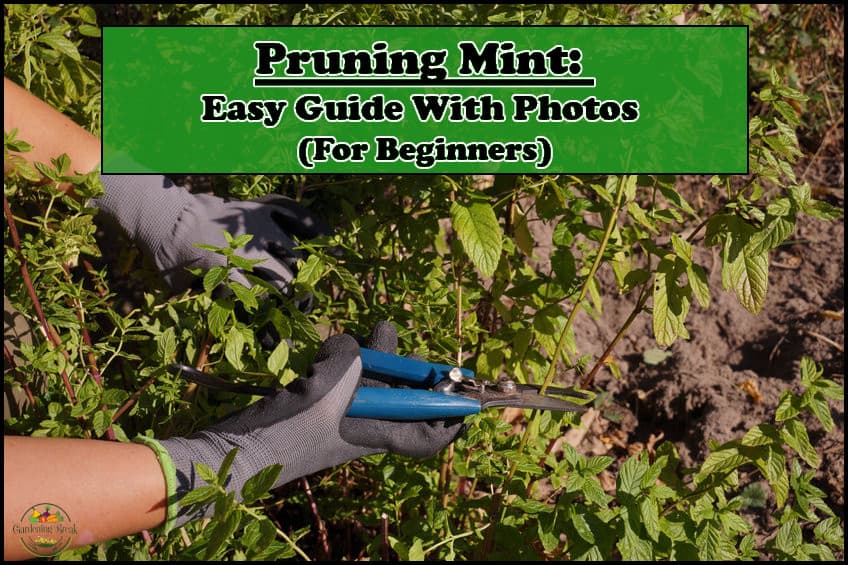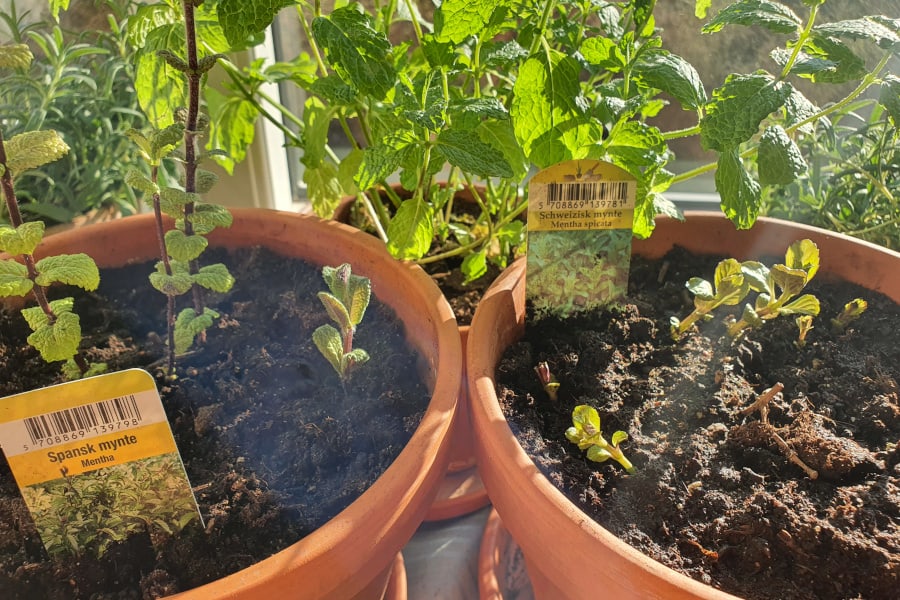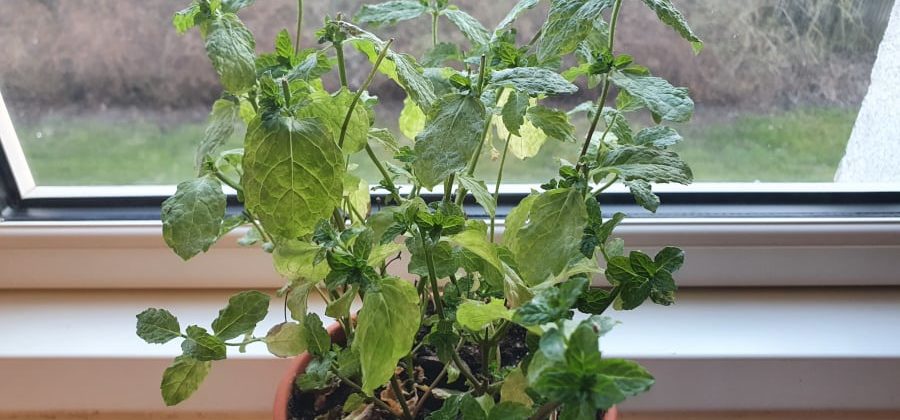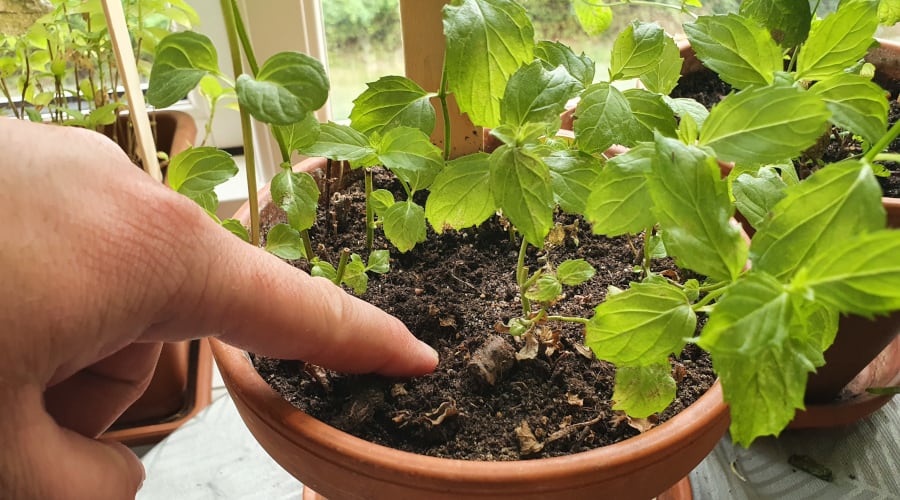This post contains affiliate links.
Knowing how to prune your mint plants is so valuable as it will not only make your mint plants bushier and nicer to look at but also much more productive. In this article, I cover the easiest ways to prune mint plants of different sizes, why and when you should prune for the best results, and more.
The easiest way to prune mint plants is to use pruning shears to cut the stems back by about half. The best place to cut mint stems when pruning is right above sets of leaves, as that will cause two new stems to grow from the ones you cut, thereby making the plant a lot more productive.
Pruning promotes new growth and is the most efficient way to make your mint plants more productive. Keep reading as I explain the easiest ways to prune your mint, no matter the size, as well as why pruning is important, what the best time of the year to prune mint is, and more tips that will help you get a super productive and nice-looking mint plant.

Why It Is Important to Prune Mint Plants
Of course, your mint might grow even if you don’t prune it at all, but not pruning it would be such a shame, in my opinion, because you would be missing out on a lot more mint than you think, and it is so easy.
Pruning mint is important as it promotes new growth and allows new stems and leaves to grow at a faster rate than before, thereby making the plant much more productive. Pruning also reduces the risk of pests and diseases attacking your mint, making it easier to take care of.
When you prune your mint, a cool trick is to take the cuttings, root them in water, and then grow them as new plants. Just take the cuttings, remove the leaves from the bottom half and place them in water covering the bottom half. After about two weeks, they can be planted in soil as new plants.
Aside from giving your mint good growing conditions (which you can learn all about here), pruning is the most important thing you can do to make your plants grow faster and better and be more productive.
Now that you know why pruning your mint is important let’s get into how you do it. Pruning small mint plants is slightly different from pruning big ones as the big ones are generally more robust and can take a heavier pruning. I cover both below.
How to Prune Small Mint Plants to Make Them More Productive

Pruning a small mint plant is great as it will make the plant bushier and more productive already from an early stage.
Small mint plants are not as robust as bigger and more established ones, so you have to be a little gentle when you prune them.
The best way to prune or trim small mint plants is to cut each stem about an inch above the third set of leaves and then again after it has produced another three sets of leaves. It is important that there are leaves left on the stems after they are cut so they can absorb sunlight, as that helps them grow back faster.
When you cut a mint stem right above a set of leaves, it will begin to grow as two new stems instead of the initial one, which essentially doubles the production compared to before. If you do this from the beginning and repeat it a couple of times throughout the season, the plant will surely become big, bushy, and super productive in no time.
You can see exactly where to cut in the photo above. As you can see, two new stems have started to grow from the joint between the main stem and the set of leaves.
When you prune your mint (and other plants, for that matter), it is important that you use some sharp and clean pruning shears to avoid damaging the plant and reducing the risk of pests and diseases taking advantage of the fresh cut. I use and recommend these pruning shears from Amazon which I bought some time ago and am really happy with.
Easiest Way to Prune Large Mint Plants or Bushes

Mint plants spread like wildfire, so they quickly grow really big if they are not contained in a pot. If you have a really big mint plant, you shouldn’t spend time cutting every stem one by one when you prune it, as that will take forever. I have a faster and easier way you can use.
The easiest way to prune large mint plants or bushes is to grab a handful of stems and cut them back by about half at the same time. Large mint plants or bushes are typically very robust and can survive heavy prunings.
The difference between pruning big and small mint plants is essentially how gentle you are. A large and well-established mint can survive almost anything, so you can be a bit rougher than with small plants. You can even use a hedge trimmer for really big mint plants instead of pruning shears to speed things up.
This method is, of course, a lot rougher than the method I described for the small mint plants. You don’t have to worry about damaging your mint though, as long as you make sure not to cut it all the way to the ground as that will make it take a lot longer before it grows back.
After a cold winter, your mint plant will probably not look very fresh and happy but rather dry and a bit boring. Don’t worry, though. Prune the dry mint plant properly, and it will grow back better than ever in the spring. I cover how below.
How to Prune a Dried Up Mint Plant After the Winter

After a cold winter, chances are your mint plant doesn’t look too good, but rather very yellow or brown and dry, but unlike a lot of other herbs, mint can actually survive the winter in most areas.
To be more precise, the stems and leaves will die when the temperatures drop below the freezing point, but the roots will almost always survive as they are protected by a layer of soil. Once it gets warmer and there is more sunlight in the spring, fresh new growth will start to appear, and there will usually be more of it than before the winter.
To give your mint the best start of the season after a rough winter, you should know how to prune it. Here is my tip:
To prune a mint plant that has dried up and become brown over the winter, cut the stems just above ground level, but do not remove any green growth. Instead, remove as much dead growth as possible to make room for new growth and reduce the risk of mold and other problems.
While this is a great thing to do in the spring if you haven’t done it earlier, I actually recommend cutting your mint back to just above the ground at the end of the growing season rather than in the spring since it can start to grow back earlier. You can read more about that on this link.
Other than just removing dead growth after the winter, there are other times when it is a really good idea to prune your mint. Below, I explain the best time to prune your mint for various situations.
When Should You Prune Your Mint? Best Time to Prune Mint

There is a lot of contradicting information online about when you should prune your mint, and to be honest, you can do it all year, but there are some advantages to doing it at certain times.
The best time to prune or trim mint is in the summer, just as the first flowers appear. Doing so will delay the flowering process and extend the growing season.
As mentioned, you can prune mint more or less whenever you want. The only thing you have to keep in mind is that the more you cut back your mint, the longer it takes for it to grow back to the same size, but the bushier and more productive it will also become.
I generally prefer to give my mint plants some light prunings several times throughout the season and then a heavy pruning in the summer as described above to extend the growing season.
The light pruning I do is essentially just harvesting, but instead of just picking some leaves, I cut or pinch the stems as that also makes them split in two, just like regular pruning. If you do this, just make sure you don’t harvest from the same part of the plant all the time, but switch between harvests to allow it to grow back properly. You can read more about how to harvest mint so it keeps growing in this article.
Gardening Know How seems to agree that it is good to frequently do some light pruning by pinching off a few stems whenever you need some in the kitchen.
Pruning your mint before it begins to flower will extend the growing season and make it produce more leaves, but you might actually want it to flower. There can be multiple reasons why you would want your mint to flowers, such as attracting pollinators to your garden, collecting seeds, or even using the flowers in salads or other dishes. Below, I explain when you should and shouldn’t remove the flowers from your mint.
When You Should and Shouldn’t Remove Flowers From Mint
Whether or not you should remove the flowers from your mint plant depends on what you want to get out of the plant.
| Remove the flowers from your mint if: | Do not remove the flowers from your mint if: |
| You want it to keep growing so you can harvest more leaves | You want to attract pollinators to your garden |
| You want to reduce the overall size of the plant with a heavy pruning | You want to collect seeds from the plants |
| You want to harvest the flowers to use them in cooking | You enjoy how the flowers look in your garden |
| You want to use the flowers for decoration | You don’t mind that the leaves lose a bit of taste |
Most people probably just want to be able to harvest as many leaves from their mint as possible. If you are one of those people, remove the flowers as soon as they appear. The faster, the better.
If you have a garden with several different plants you might want to consider letting your mint flower to attract bees. You definitely shouldn’t underestimate the effect of having bees and other pollinators in your garden. They help spread the pollen from your plants, thereby pollinating them and increasing the overall production of your plants.
Even large-scale agricultural projects use honey bees for pollination and increase the value of the projects by billions of dollars every year. You can read much more about that in this report from Cornell University.
That’s how good bees are in your garden, so keep that in mind when you decide if you should let your mint flower or not.
If you have multiple mint plants, I recommend doing both. Remove the flowers from some of them to keep them growing and producing, and let the flowers stay on some of them to attract pollinators.

